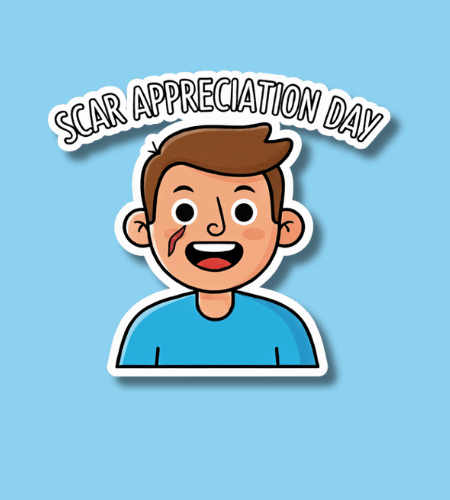Every year on 22 October, we observe National Scar Appreciation Day, a thoughtful occasion dedicated to recognising and honouring the scars—visible or invisible—that mark our journeys through life. This day shines a light on the survival, strength and stories behind these marks, inviting people to embrace their scars as symbols of resilience, healing and personal growth.
Table of Contents
History of National Scar Appreciation Day
National Scar Appreciation Day was founded in 2019 by Justine Faeth after her own experiences with multiple surgeries and the emotional and physical marks left behind. The idea was to create a space where scars are not hidden or dismissed, but instead celebrated for what they reflect: life lived, challenges faced, and strength gained.
Over time the observance gained traction through social‑media campaigns and personal storytelling, becoming a meaningful moment each year for individuals and communities to share their scar‑stories, reduce stigma around physical and emotional reminders, and support one another in journeys of healing.
Why is National Scar Appreciation Day important?
At its heart, National Scar Appreciation Day reminds us that scars—whether from surgery, injury, illness or emotional trauma—are more than blemishes; they are narratives. They are evidence that something happened, that someone endured, and that someone continues. Recognising these marks shifts the frame from shame to survival, from hiding to owning. It gives people permission to view their scars not as flaws but as foundations of identity.
Moreover, this day underscores how vulnerability connects us rather than isolates us. When we share the story behind a scar, we invite empathy and understanding. We communicate that healing is not linear, that scars matter, and that the journey of healing can foster community. In that sense, the day becomes an act of quiet solidarity: each scar acknowledged becomes a bridge between lived experience and the shared human need for acceptance and belonging.
Here are some reflections:
- acknowledging scars as part of who we are
- shifting self‑perception from wounded to wise
- offering others the space to share their own scar‑stories
- recognising that healing is visible and invisible
- building solidarity through openness and authenticity
How to Observe National Scar Appreciation Day
Observing National Scar Appreciation Day doesn’t require grand gestures—it can simply begin with honest recognition. Perhaps you take a few minutes to look at a scar you carry (or a memory of one) and reflect on what that mark means: what you’ve been through, what you learned, how it shaped you. You might write a short note about it, share it with someone you trust, or simply allow yourself to feel the mixture of gratitude and growth that often sits behind such marks.
You could also reach out in community: invite someone else to share their scar‑story, or support an organisation that helps people recover from trauma, surgery or illness. Sharing and listening transform the day from individual observance into collective acknowledgement.
Here are some simple ideas:
- write a short note about a scar you have and what it means to you
- share a photo or story (your own or someone else’s) about a scar and the journey with it
- invite a friend or family member to talk openly about scars and healing
- support a charity or initiative that helps people recover from surgery or trauma
- spend time simply reflecting on how your scars have contributed to your strength
National Scar Appreciation Day Dates Table
| Year | Date | Day |
|---|---|---|
| 2025 | October 22 | Wednesday |
| 2026 | October 22 | Thursday |
| 2027 | October 22 | Friday |
| 2028 | October 22 | Sunday |
| 2029 | October 22 | Monday |
Subscribe to our newsletter and never miss a holiday again!

